Optimizing for featured snippets is worthwhile for a lot of organic search marketers. Even though some recent research shows the featured snippet position has a lower click-through rate than the first classic snippet, other research has featured snippets receiving 35% of all clicks.
There seems to be a lot of variability in how well users click-through on featured snippets. I think the low CTR figure from Ahrefs is due to only using SERPs that didn’t have any ads. I think a keyword search that doesn’t result in ads means Google determined those users aren’t interested in clicking on anything and just wanted a quick answer.
In my experience, capturing the featured snippet position is worth the effort. The featured snippet is the most prominent organic snippet, and I definitely see sudden increases in sessions when a client’s blog captures the spot. I think my target users click because the content of the featured snippet box suggests the answer they’re looking for is on the page.
Obtaining the featured snippet position is tricky, though. In my previous article about how to get featured snippets, I said that we might have to make multiple attempts and not go over the display limit when we’re writing our candidate snippets. I cited research from A.J. Ghergich and SEMRush that said the optimal paragraph featured snippet length is “roughly 40 to 50 words, or around 300 characters.”
The problem is that recommendation only works for paragraph snippets, not lists or tables. “Around 300 characters” is pretty loose; can we get more definite? When I looked at meta description lengths in snippets, there was a pretty clear drop in frequency that indicated an upper bound. Would frequency charts for featured snippets clue us into that? (It turns out there are a few clear limits, like very few more than 320 characters for paragraph snippets.)
I asked our SEO fellow and resident software engineer Matthew Henry to help me do another data-driven research project to see if we could pull some insights out of scraped SERP data. Heroically, he sifted through Google’s bizarre HTML to identify featured snippets and compile their stats. This post shares what we uncovered about how Google treats featured snippet length and display limits.
Methodology
We used the same list of 30,000 keywords taken from our existing and previous clients as we used in our earlier research about meta descriptions. Once again, we used the full HTML SERP export feature of STAT Search Analytics.
We weren’t able to parse Google’s mobile results, so the data in this article is for desktop featured snippets only. Of the 30,000 initial keywords, 7,854 of them had featured snippets that we included in this research. We don’t recommend using that figure for how often featured snippets appear. Overall featured snippet appearance rate has already changed a few times this year and is better tracked over time like Mozcast and RankRanger do.
We didn’t cover all of the various forms featured snippets can take, just what we thought were the most common: paragraphs, lists, and tables. We also looked at how the presence of images changed snippet length, so some results will be segmented by the appearance of zero, one, and a carousel of images. We were careful only to include what we thought were true featured snippets, and not Knowledge Graph features that use text excerpts.
Paragraph Featured Snippets
Paragraph featured snippets are some of the most common and easy to target. They generally appear as a few sentences of text and can have one or more images present in the snippet.
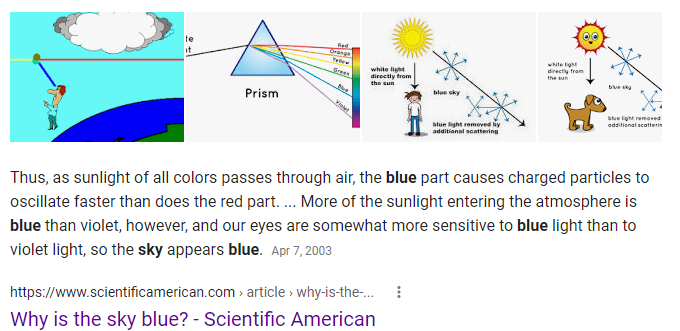
There are a few exotic forms, like a stack of two snippets or a carousel of snippets, but they are rarer, and we think their display limits are going to be pretty similar to the normal ones.
Images in Snippets
Google likes to include images in featured snippets. Sometimes they will include images from a different website than the source text, but how often do they include images in the first place?
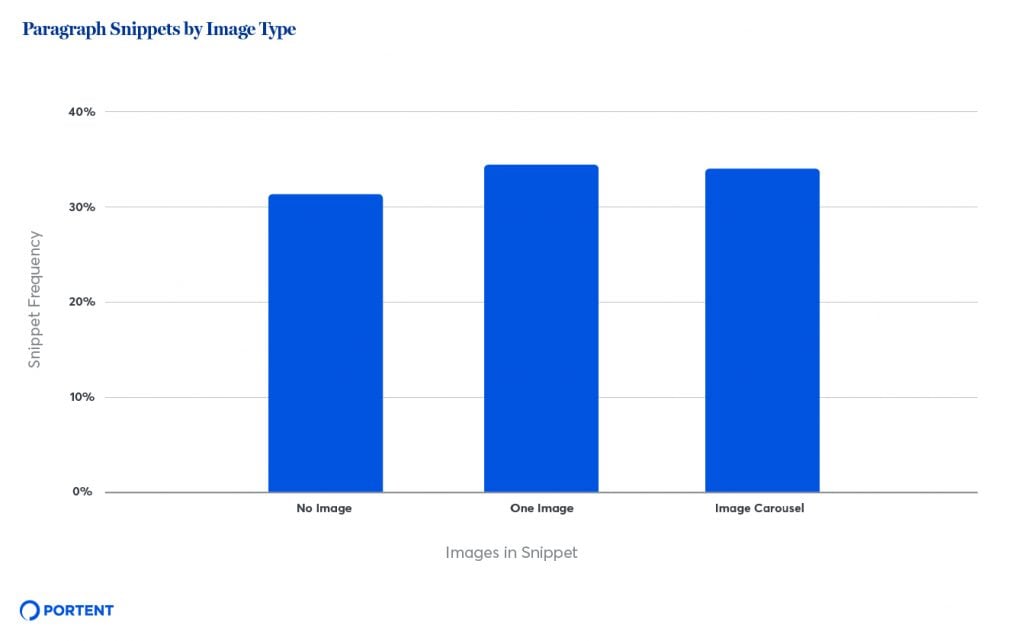
Each type of paragraph snippet occurred fairly equally, with snippets without an image occurring slightly less often.
If images show up in snippets so often, it’s a good idea to think about what kind of images would help support the content you’re writing for paragraph snippets and put them on the page.
Number of Sentences
Paragraph snippets tend to have 2 to 3 sentences per snippet. There were very few snippets with 4 sentences, and none with 5. I don’t think it’s the case that Google wants to show 2 or 3 sentence snippets specifically, but content that long tends to fit into the available featured snippet space. It’s also rare to see single sentences that are 40 to 50 words long; they are hard to read, and users don’t react to them well.
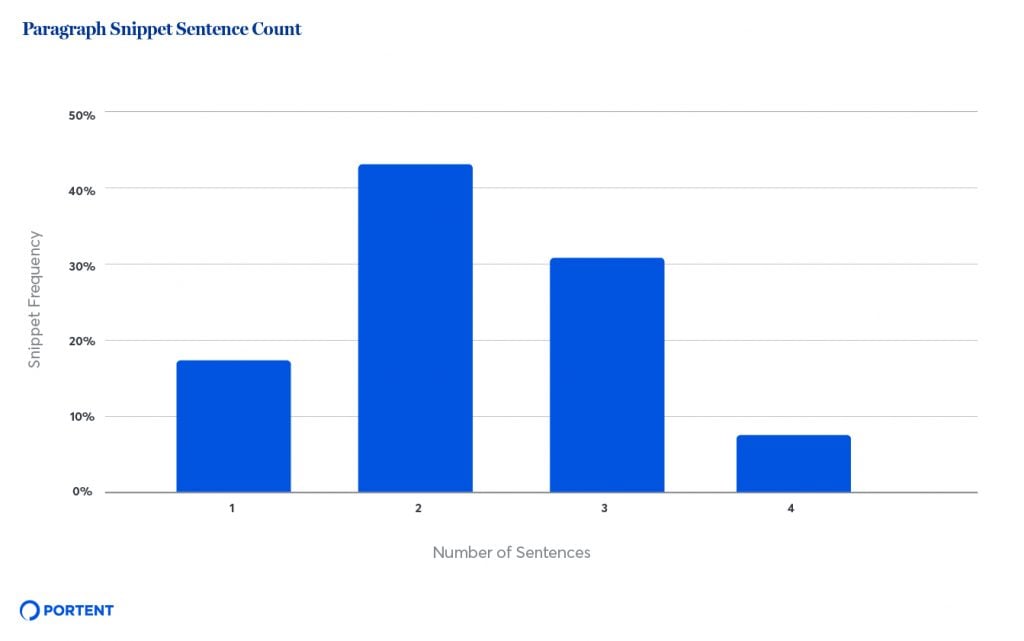
The lack of snippets with 5 sentences is curious. Maybe Google doesn’t consider more than 4, but it could be that brands don’t tend to write 5 short sentences.
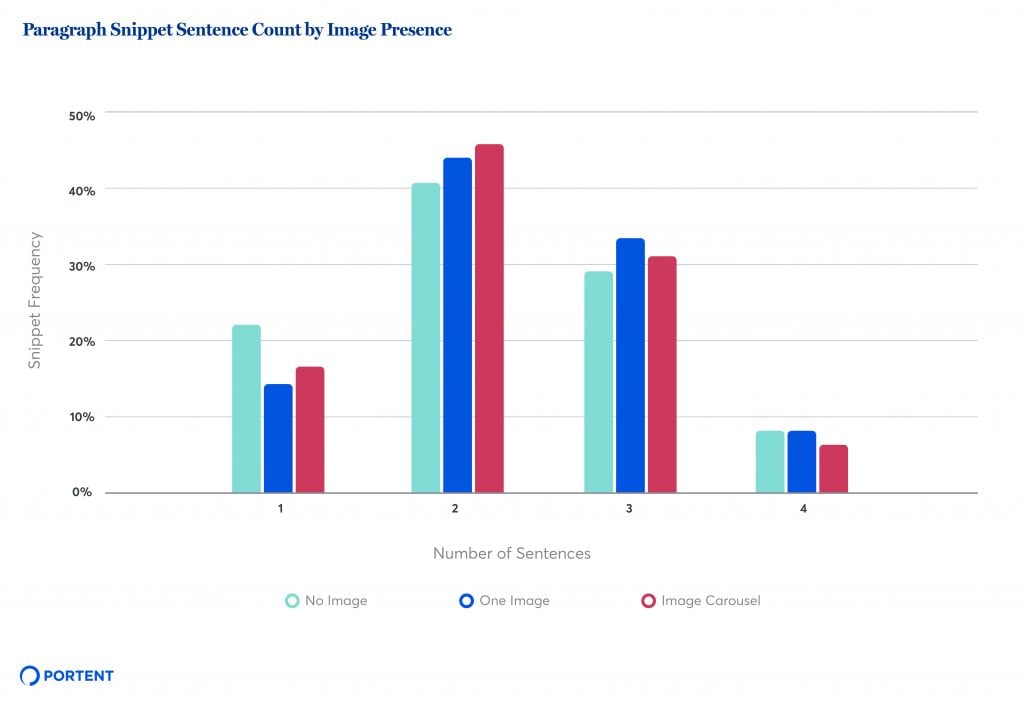
When segmented by image presence, paragraph snippets with no image are slightly more likely to be one sentence long. This might be due to single-sentence direct answer type snippets.
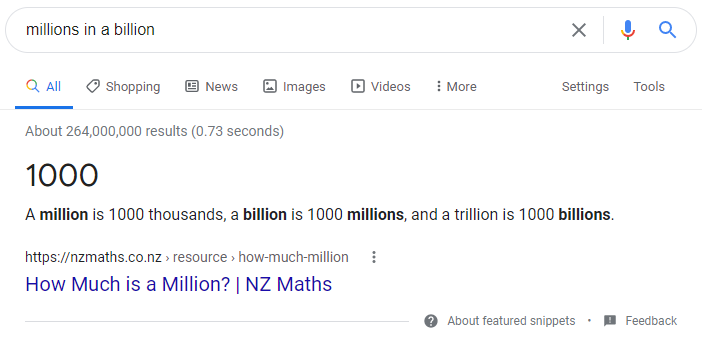
We didn’t count “answer lines” like “1000” in the screenshot as a sentence, as it appears to be Google doing a little processing on the snippet text.
Consecutive Sentences
Ever notice how some paragraph snippets have an ellipsis between sentences, like in the earlier screenshot for “why is the sky blue”? This is Google taking text from two parts of the page and sticking them together for the snippet. How many snippets are non-consecutive like this?
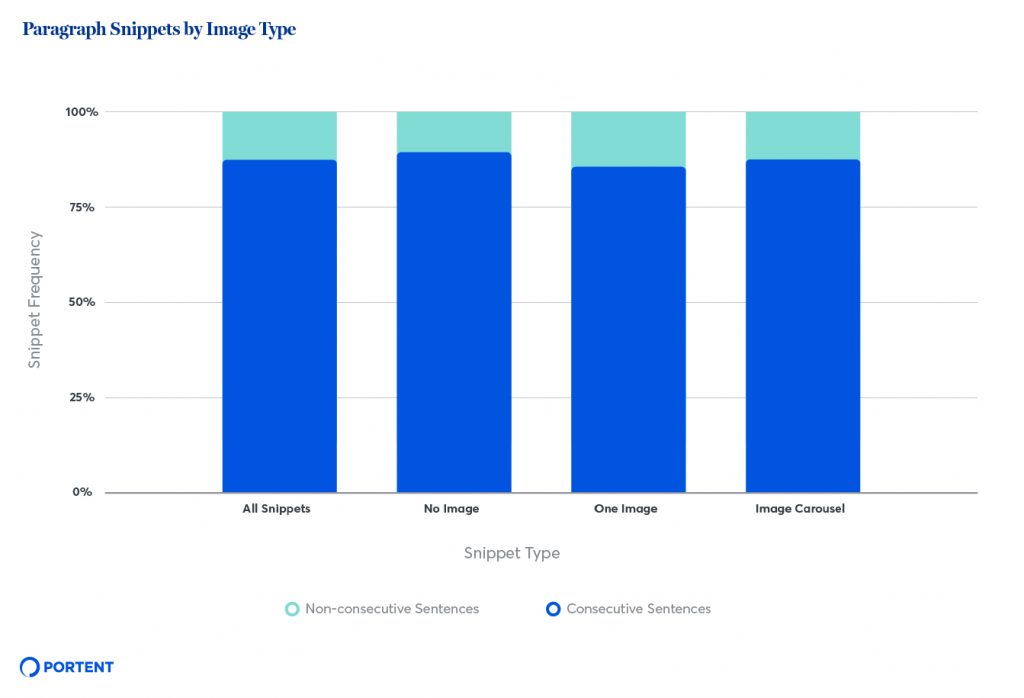
Only about 13% of paragraph snippets use non-consecutive text, and image presence doesn’t look related. One interesting thing we found is that there were no snippets with three non-consecutive sentences. It seems like Google will only take text from up to two parts of the page for snippets.
Anecdotally, Google does this because there isn’t suitable consecutive text to use. I expect these snippets to become less frequent over time as more SEOs attempt to replace them with tailored consecutive text.
Word Count
The Ghergich & Co./SEMrush research found that paragraph snippets tend to be around 40-50 words. We found a pretty similar result, but 55 words in a snippet was pretty likely too.
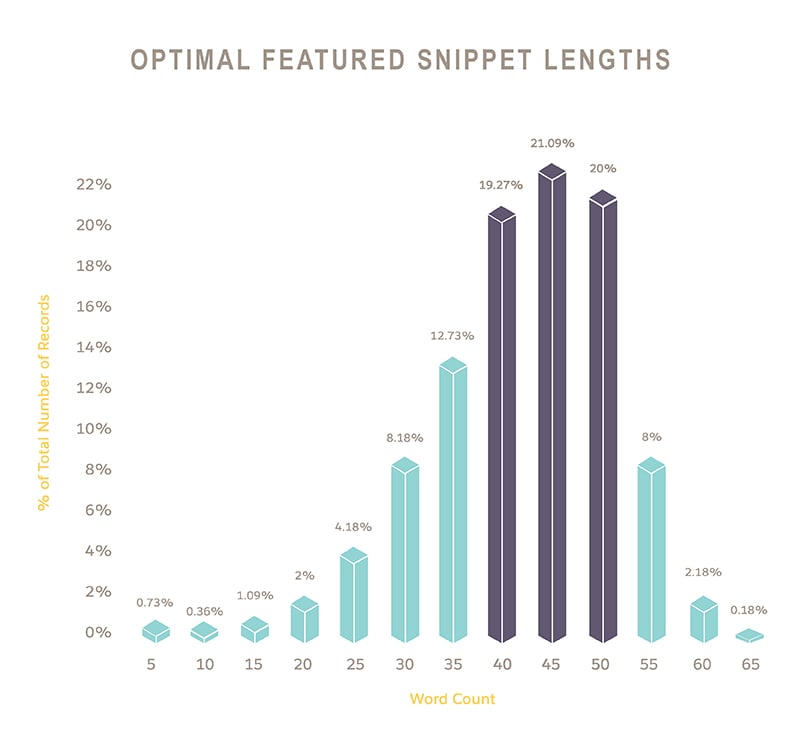
We found higher word counts to be slightly more likely than what A.J Ghergich found. Since there were a few years between our projects, some drift should be expected.
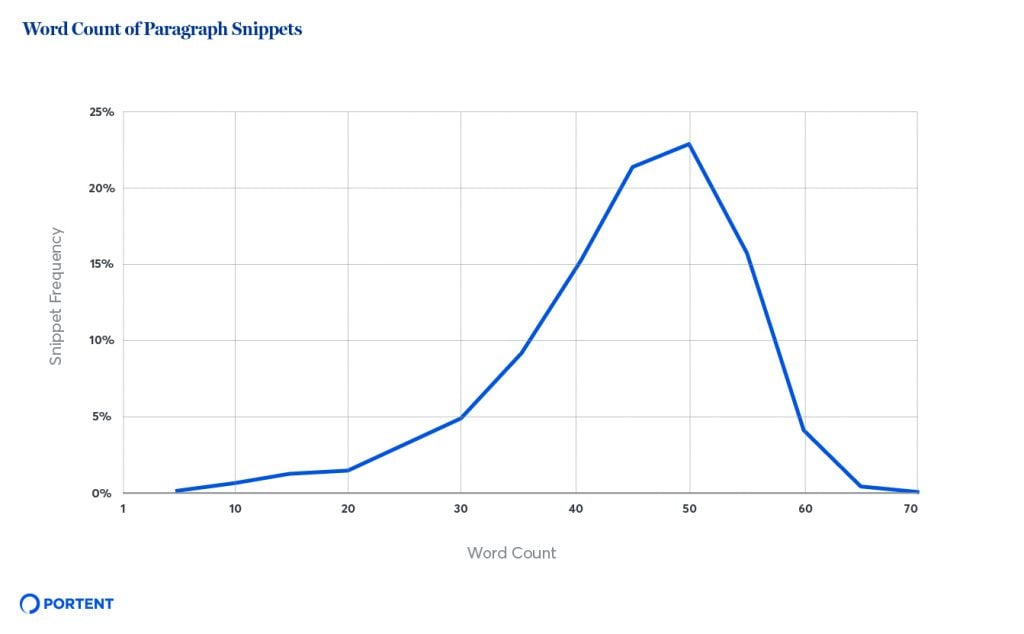
I wouldn’t say 40-55 words is “optimal,” since I doubt Google is looking for a particular word count, but it is a helpful target to give people. Non-SEOs don’t have to think about character counts very often, so a word count is more natural.
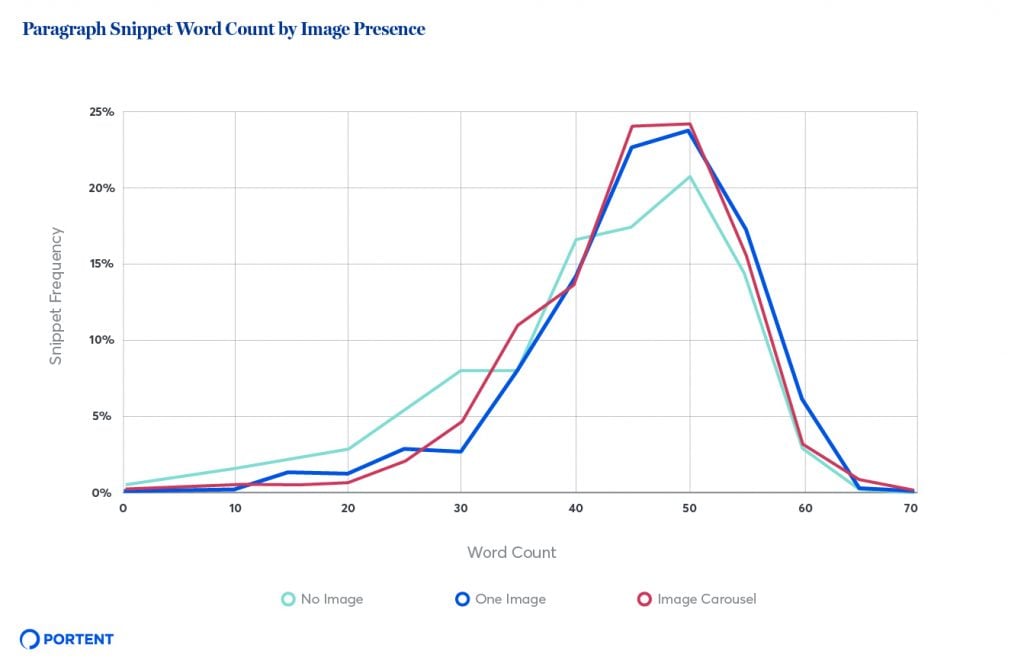
Once again, snippets without an image are more likely to be shorter than the others. It could be those shorter direct answer snippets that are skewing the distribution shorter.
Maximum Characters in a Paragraph Snippet
For a long time, I assumed the display limit on paragraph snippets is based on pixel width as with title and meta descriptions. But this chart made me reconsider.
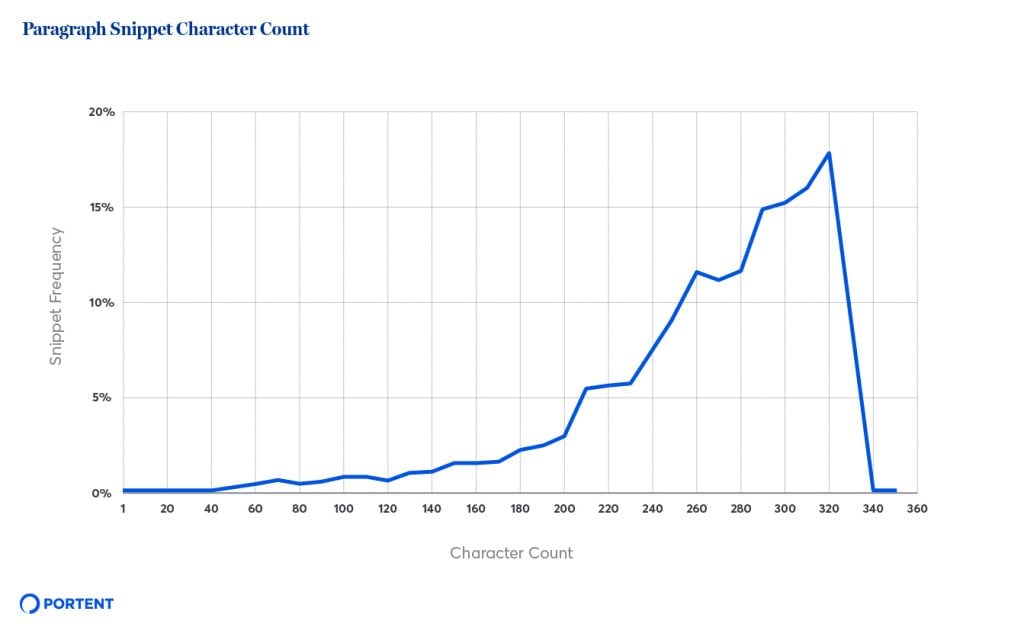
The acute drop in frequency after 320 characters is highly suggestive. Some snippets that had more, but only up to 324 characters and none after that. Matthew found that Google sometimes “corrects” the text it uses for snippets to use proper punctuation, and I think that could explain it.
If there is a hard 320 character source text limit, the few we saw over 320 characters could be caused by Google adding periods, spaces, ellipses, etc., when needed.
Even if there isn’t a hard 320 character limit, I’ll still instruct people not to go over it when writing text intended for paragraph snippets.
List Featured Snippets
Something I’ve noticed missing from featured snippet research are statistics on list and table snippets. How long do they tend to be? How many list items or rows do they have? How long do entries tend to be?
The lack of this information could be due to how hard it is to parse Google’s HTML. Luckily Matthew was able to hammer on it until some data fell out. One observation is that 63% of list snippets were bullet point lists, or unordered lists.
Another observation is that an overwhelming number of list snippets have a heading at 96%. It seems like Google really wants to display lists with a label, so provide the one you would like Google to display.
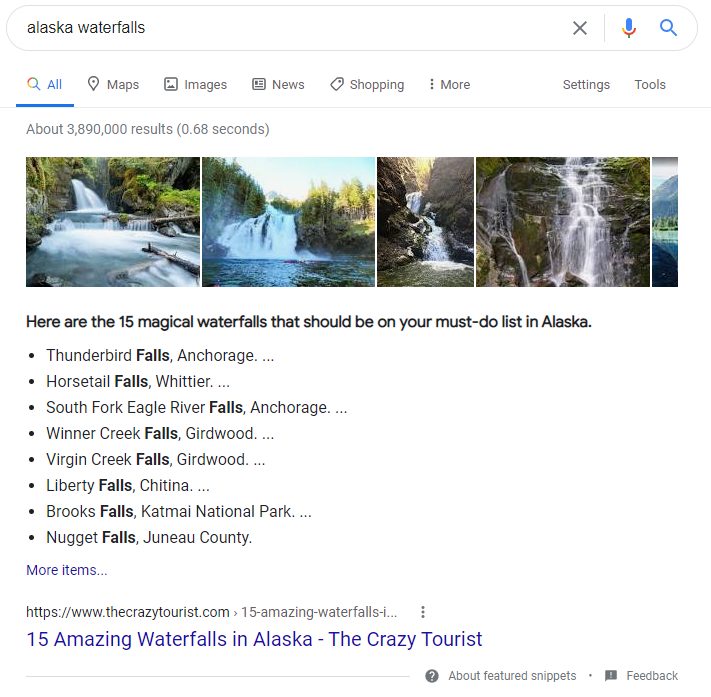
Images in List Snippets
Compared to paragraph snippets, list snippets with images occur more frequently. We found that only 29% of list snippets didn’t have an image.
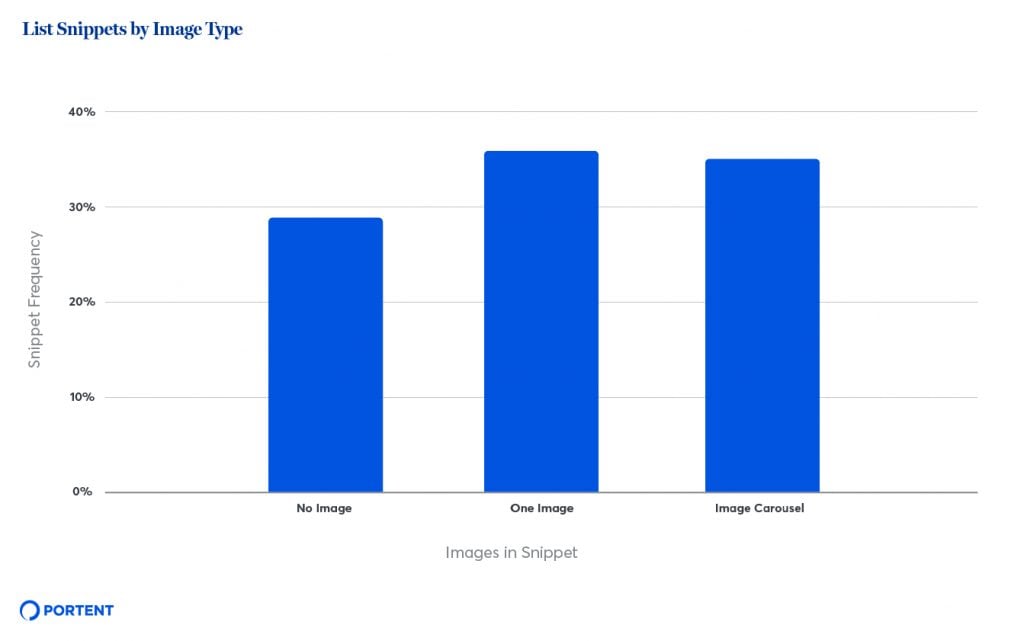
The explanation for this lower frequency of list snippets without images is hard to guess. The simple answer I thought of is that users searching for lists of things need an image of at least one of those things to confirm the list is relevant to their query.
List Snippet Entry Count
Next, we wanted to explore the frequency of list snippets as it relates to how many rows, or list items, they featured.
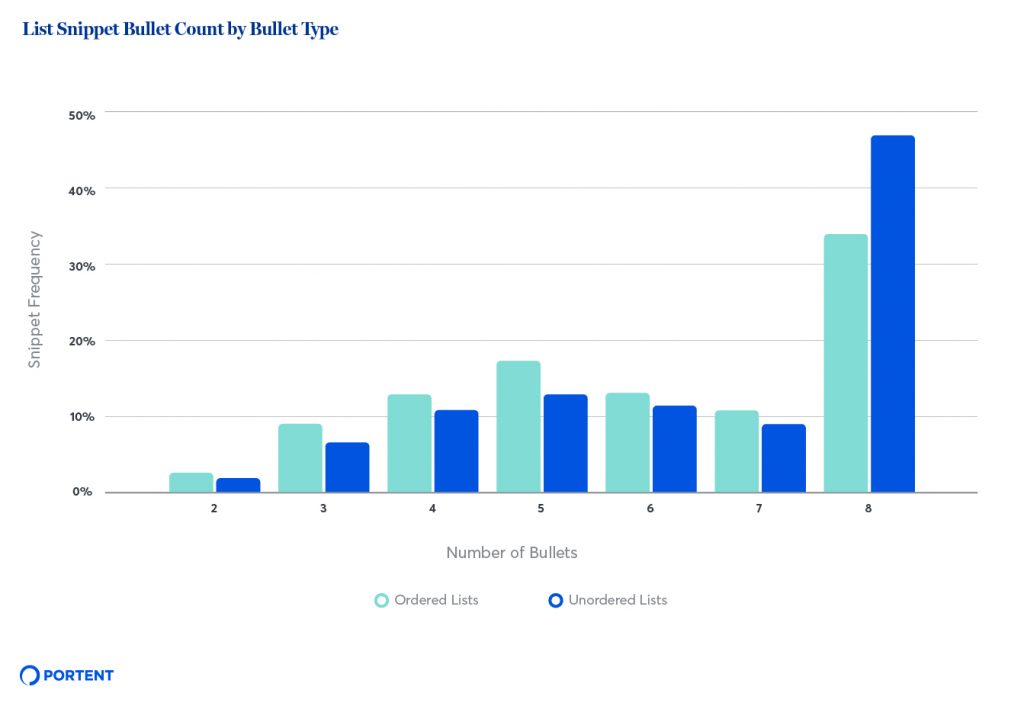
A few things stand out in this chart:
- 8 entries is the most common amount, and the maximum
- 5 is the second most common number of entries in a list snippet
- Ordered lists (numbered lists) tend to have fewer entries
We didn’t find any snippets with more than 8 bullets, so 8 looks like the maximum. 8 is clearly the most popular for the snippet type, but that doesn’t necessarily mean it’s optimal. Not pictured here are the lengths of the source lists. Lists with more than 8 entries are getting truncated down in the snippet.
One takeaway definitely is not “make your lists 8 entries long.” The source lists could be any number long, and their rate of being sourced could be closer to the percentages we see in the chart for 2-7 bullets.
The second most common number of bullets is puzzling. Why 5? Why not 7? It could be due to the natural frequency of list lengths on the web, or 5 is a good square number to display longer list items.
Fewer items in ordered lists could be due to fewer ordered items in the source text, or the items tend to be longer than just names of things. Many ordered lists will appear for how-to and “best” queries, and those could get verbose.
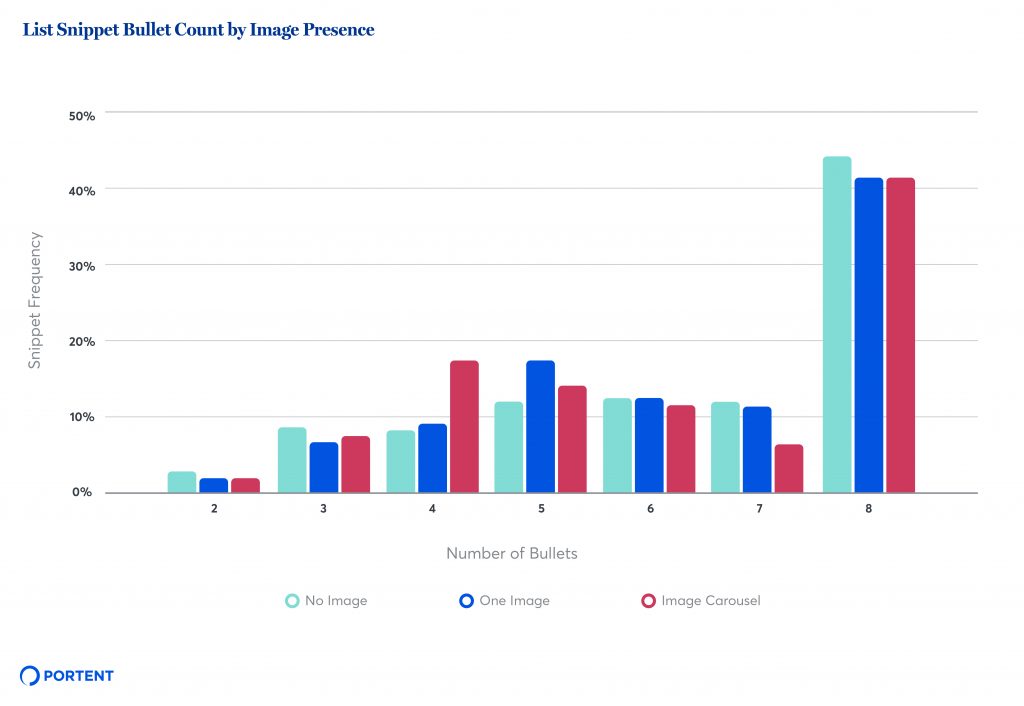
Images in the snippet correlate with generally the same number of bullet points as ordered and unordered, but with unusually high or low frequencies at different numbers of bullets. I don’t have any guesses why these are happening.
Word Count of Individual Bullets
List snippets need to have short bullet point text if Google is going to display 8 of them, and I think that explains part of the results of bullet word length.
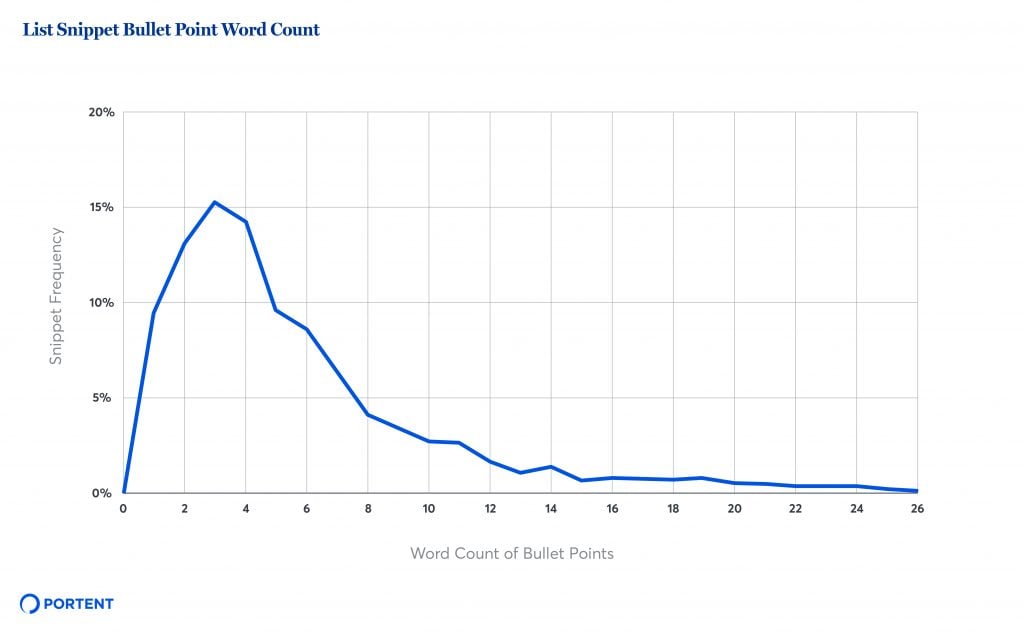
This distribution has the mode at 3 words while there is a very long tail. Not pictured is the end of the tail at 39 and 40 words. It seems like bullet points can get pretty long if the content is relevant. Keep your list items focused if you want them to be fully displayable.
Bullet Character Length
The distribution of characters in a list entry is skewed similarly to word count. List items that are 10 to 50 characters long occur pretty frequently, and would likely appear in list snippets 8 bullets long.
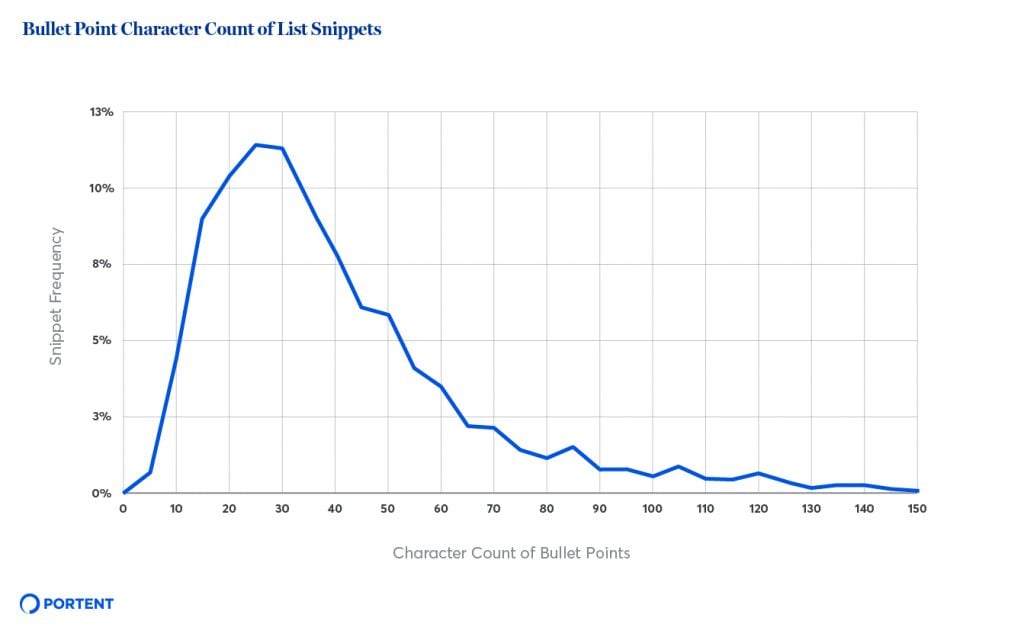
We cut the tail off this chart to make it look good. We found bullets as long as 275 characters in our data.
Total Bullet Word Count
When we summed up the words in all bullets, we found that the distribution looks a lot like the one for paragraph snippets, just flatter with fewer words.
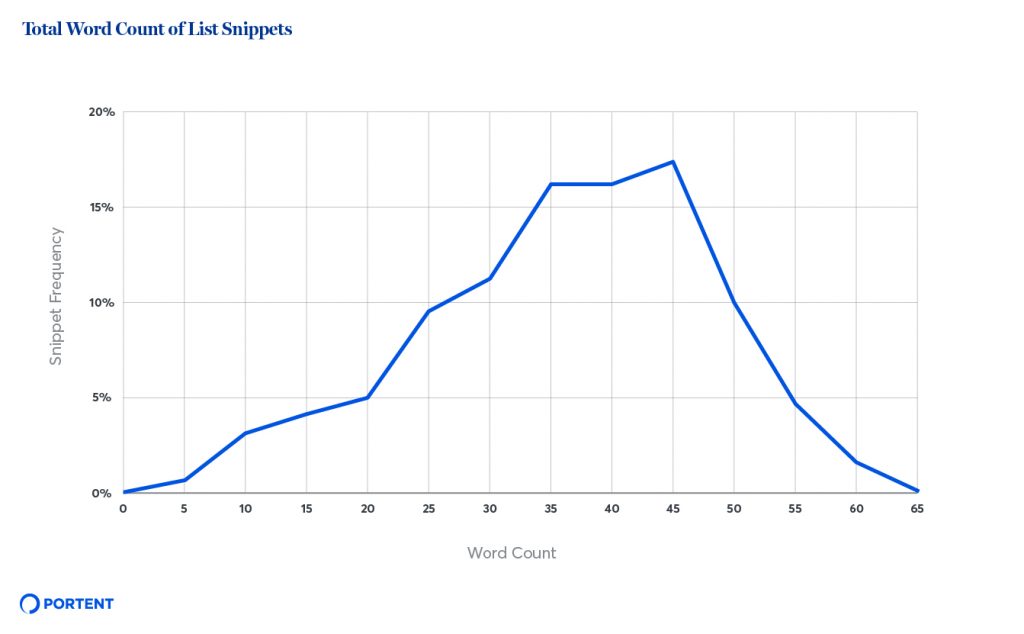
The most common word count in list snippets is 40-45 words, and the frequency of longer snippets drops off after that. There is only so much space for text in a featured snippet box, so it’s no surprise there are fewer words in lists than paragraphs—there needs to be space for the bullet points and formatting.
Total Characters of All Bullet Points
As I mentioned previously, SEOs often think in terms of character count. What would we find when we looked at the list snippet data from a character perspective?
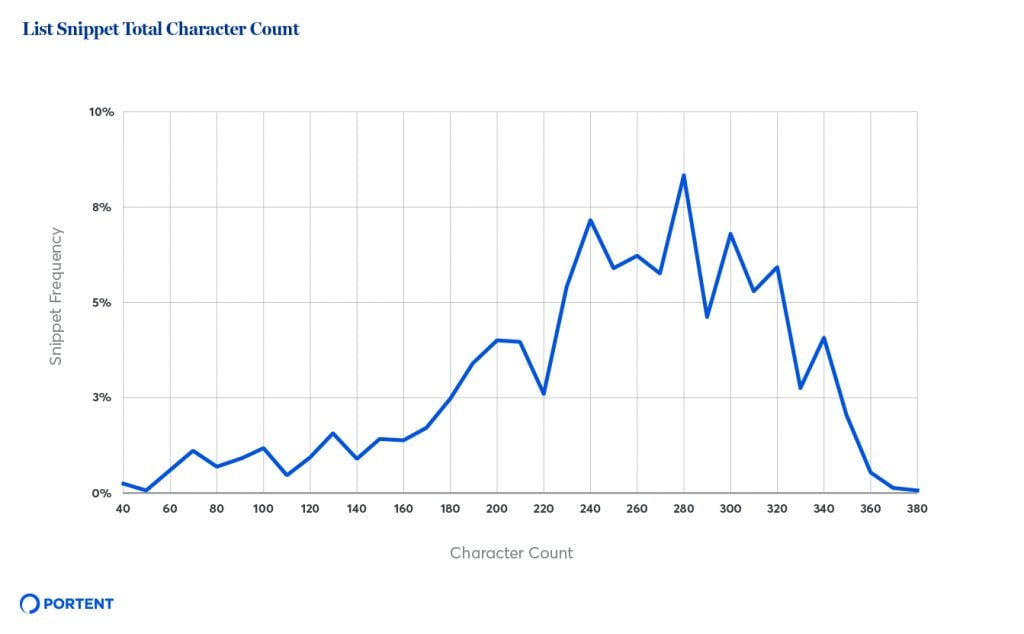
This is the least smooth chart we made, but the trend is clear: list snippets are unlikely to have a total character count over 350-370. The lack of an acute drop, as in the paragraph snippet chart, doesn’t indicate that total characters is a hard limit for list snippets.
Table Featured Snippets
Google doesn’t make a lot of space for text in table snippets, and it’s evident by how much whitespace there tends to be in the snippet box. As we’ll see in the following charts, the word and character counts per cell tend to be low.
This doesn’t mean all table snippets are low on text. Tables with few cells have more space for text, and the long tail on the word and character count distributions are consistent with that.
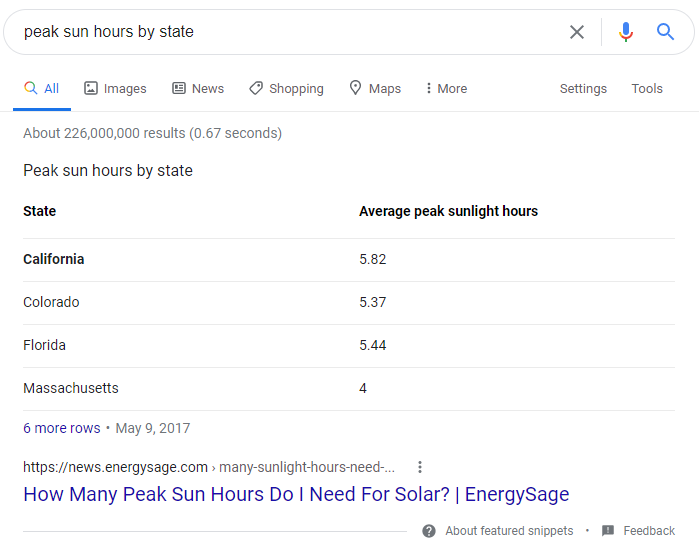
Table Dimensions
There isn’t a lot of space for tables in Google’s snippet box. Just like tables on any other web page, they are bulky and contain a lot of whitespace. Due to that, Google doesn’t display much of a table in the snippet.
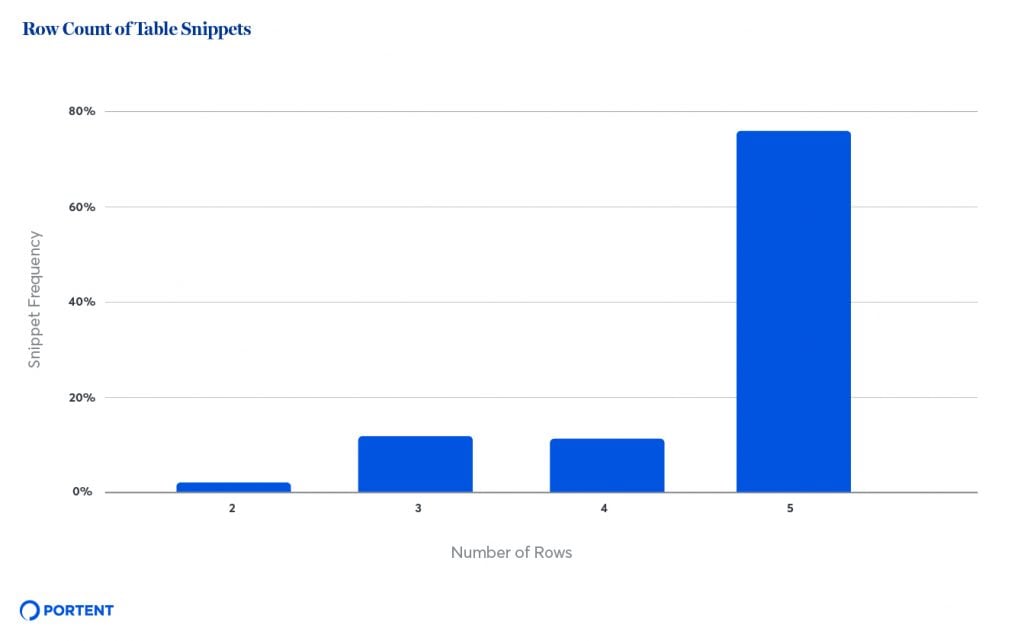
Just like list snippets, Google tends to use as much space as possible for rows. In the table snippet case, the maximum number of rows is 5. One important thing to note is that Google will use both data and table headers as the bolded top row. We didn’t differentiate between header rows and data rows in our data to reflect this.
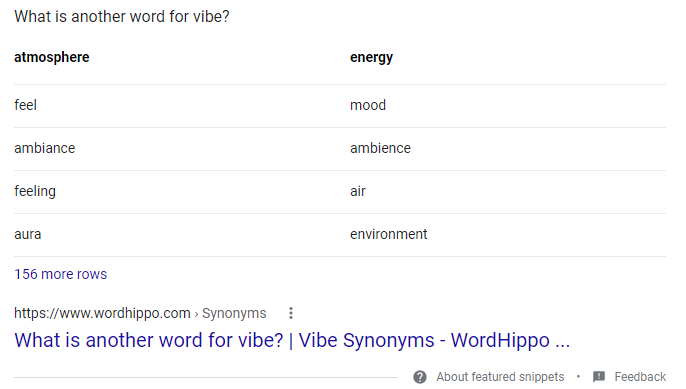
The most common tables have 3 columns. Single-column tables are rare, but they do happen, which is really weird.
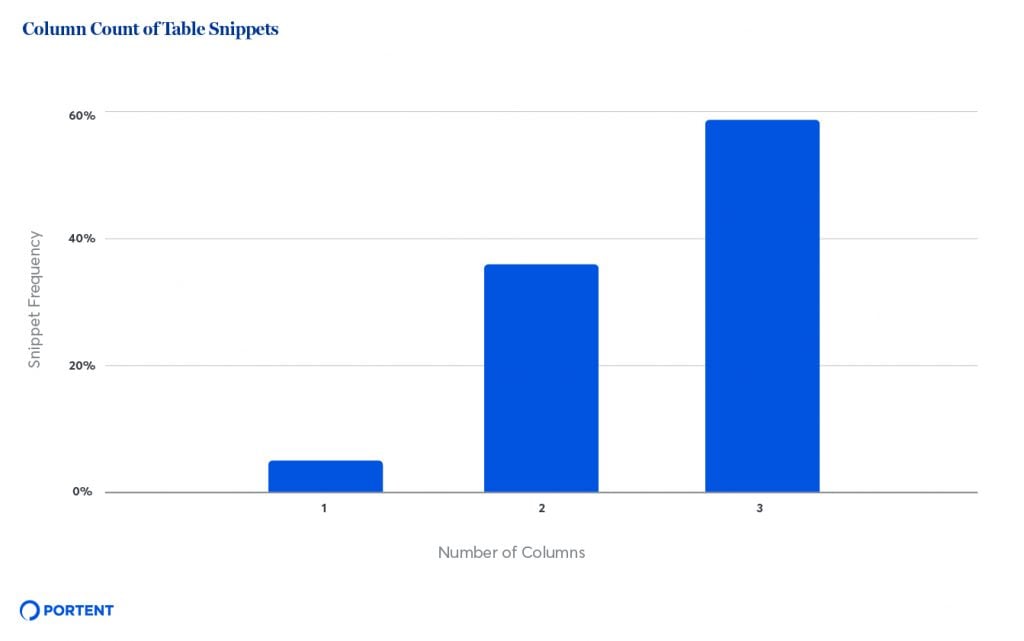
If 5 rows are the most common and 3 columns are the most common, are 5×3 tables the most common dimensions? In this case, yes.
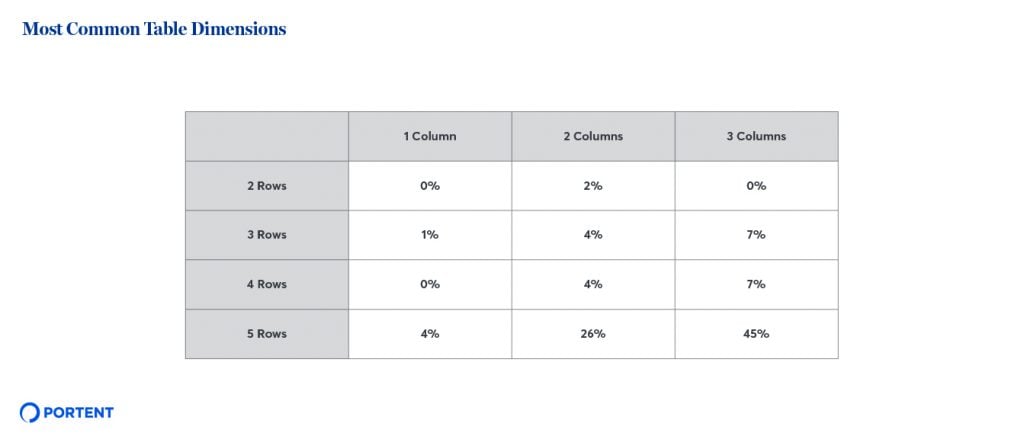
5×3 and 5×2 tables dominate as the most common table dimensions. Other dimensions weren’t found at all. This might be due to Google trying to display the most relevant information to users. If fewer cells in a table contain a lot of relevant text, it seems Google will forego more cells to show more text.
Table Cell Word Count
If 3 column tables with 4 or 5 rows are the most common, that means a lot of snippet space is being taken up by formatting, leaving not a lot of room for text. We can see this happening in the words per table cell distribution.
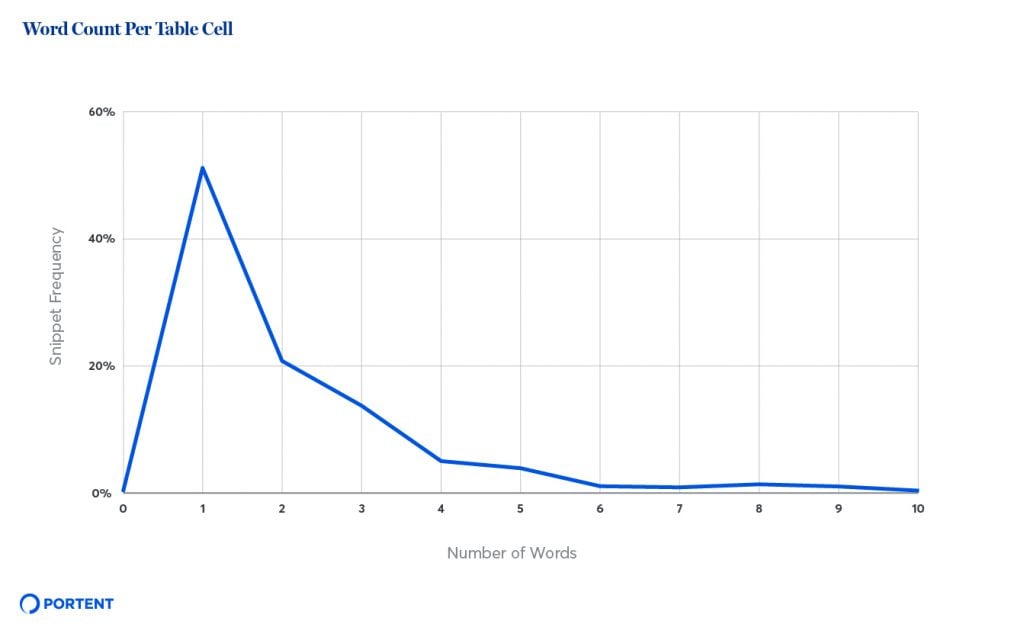
This is another distribution with a long tail. We found table cells with up to 31 words in one cell.
85% of table cells contain 3 words or less. The relatively few words per cell means a lot of tables just list numbers and entities, which is what we would expect.
Table Cell Character Count
If the majority of table cells contain up to 3 words, the total number of characters per cell should be similarly small. There isn’t a lot of room to work with in 5×3 and 5×2 tables.
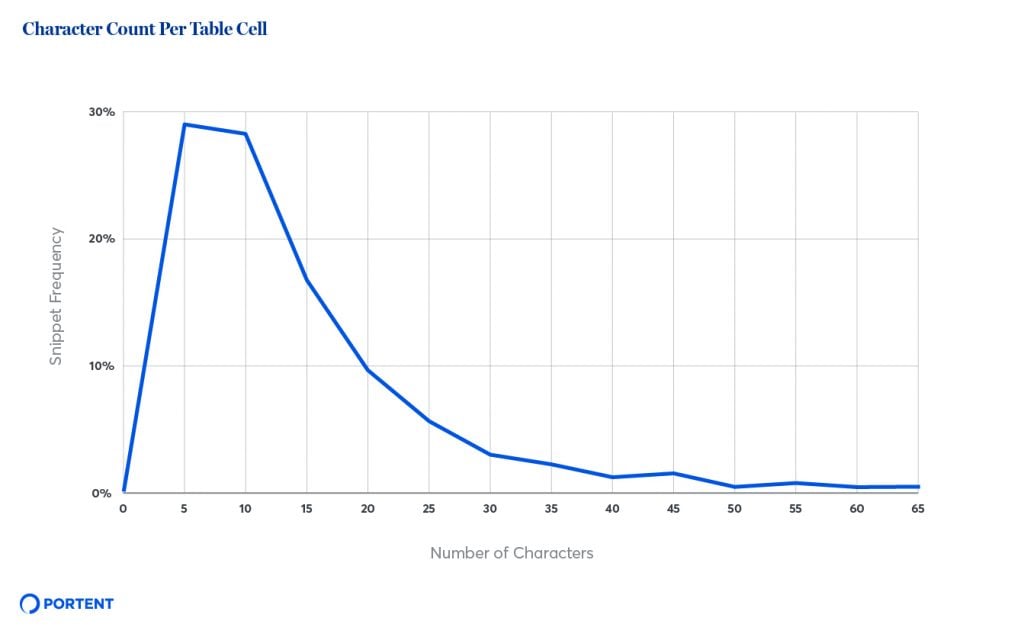
89% of table cells contain 25 characters or fewer. Once again, this is a distribution with a long tail. We found cells with up to 167 characters.
If you’re trying to optimize a current table snippet you occupy, or trying to capture one, see if you can keep the displayable cells short and to the point. There isn’t a lot of displayable space in each one.
What to Do With This Information
I think the best way to understand these statistics is that Google only has so much space to display information in the featured snippet area, and these lengths are the most Google can show due to its circumstances. I think it’s incorrect and misleading to say that the most common sizes are “optimal.”
What’s optimal is showing users that our content is likely to contain the answer to their query, and they should click through. These charts should be a guideline when writing content to see what we can get away with.
If Google or its users have a bias toward certain lengths of text, I don’t think they are apparent in our data. More reliable measures for bias would be click-through rate, or even better, some kind of satisfaction score like click-through-and-stay rate. None of those capture what is of key importance to Google: the rate at which users click-through and continue to come back to Google in future sessions. That metric may not even correlate with featured snippet length.
Future Research
We want to do things differently next time around. Our initial list of keywords wasn’t categorized; it was just non-branded keywords that generated the most clicks. If we could add more dimensions to the data like type of page, type of website, presence of other features on the SERP, and location on the source page, we could get more insights. What types of queries tend to return list and table snippets?
A lot of those things are difficult, though. The next step for us would be figuring out how to parse mobile SERP HTML. Snippet location on the source page is definitely a tough one to crack.
We’ll come back to this research in a year or two. I think the next topic for us is title tags in snippets. How long they tend to be, how often Google uses the H1, and so on. Until then, I look forward to others’ research in featured snippets. Multiple perspectives are going to give us a better idea of what’s going on.









